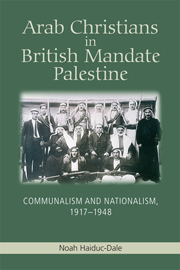Book contents
- Frontmatter
- Contents
- List of Illustrations
- Acknowledgements
- Introduction: Nationalism and Religious Identification
- 1 1917–1923: Balancing Religion and National Unity
- 2 1923–1929: Christians and a Divided National Movement
- 3 1929–1936: Towards Communalism
- 4 1936–1939: Standing Aloof? Arab Christians and the Great Revolt
- 5 1940–1948: National Strength through Communal Unity
- Conclusion: Nationalism and Communal Identification – Conflicting Identities?
- Bibliography
- Index
Introduction: Nationalism and Religious Identification
Published online by Cambridge University Press: 05 October 2013
- Frontmatter
- Contents
- List of Illustrations
- Acknowledgements
- Introduction: Nationalism and Religious Identification
- 1 1917–1923: Balancing Religion and National Unity
- 2 1923–1929: Christians and a Divided National Movement
- 3 1929–1936: Towards Communalism
- 4 1936–1939: Standing Aloof? Arab Christians and the Great Revolt
- 5 1940–1948: National Strength through Communal Unity
- Conclusion: Nationalism and Communal Identification – Conflicting Identities?
- Bibliography
- Index
Summary
I am not Christian, nor Buddhist, nor Muslim, nor Jewish. I am not Arab, or English, or French, or German, or Russian, or Turkish, but I am one of the human race.
Khalil al-Sakakini, 26 March 1915If I enjoy any position in this land, if the people love me and respect me, it is because they think that I am nearer to Islam than to Christianity, because I am wealthy in the Arabic language, because they fancy that I am a conservative and will not depart from Oriental customs under any circumstances.
Khalil al-Sakakini, 12 December 1932My first exposure to the Palestinian–Israeli conflict came in high school when I travelled with a group of American teenagers for a month-long stay with Elias Jabbour, founder of the House of Hope in Shefaᶜamr, an Arab–Israeli village near Haifa. Jabbour, a Melkite Christian, framed his approach to the conflict through his religious beliefs, describing himself as ‘a Christian, Palestinian, Arab, Israeli’. Two years later, while living and studying the conflict in Jerusalem as a college student, I was confused when the programme director insisted that the conflict was not about religion at all, but about land, economics and politics. This academic argument did not match up with the explanation I had been given while living in Shefaᶜamr. How could religion not be integral to the conflict, when those who were living in it insisted it was essential?
- Type
- Chapter
- Information
- Arab Christians in British Mandate PalestineCommunalism and Nationalism, 1917-1948, pp. 1 - 18Publisher: Edinburgh University PressPrint publication year: 2013



